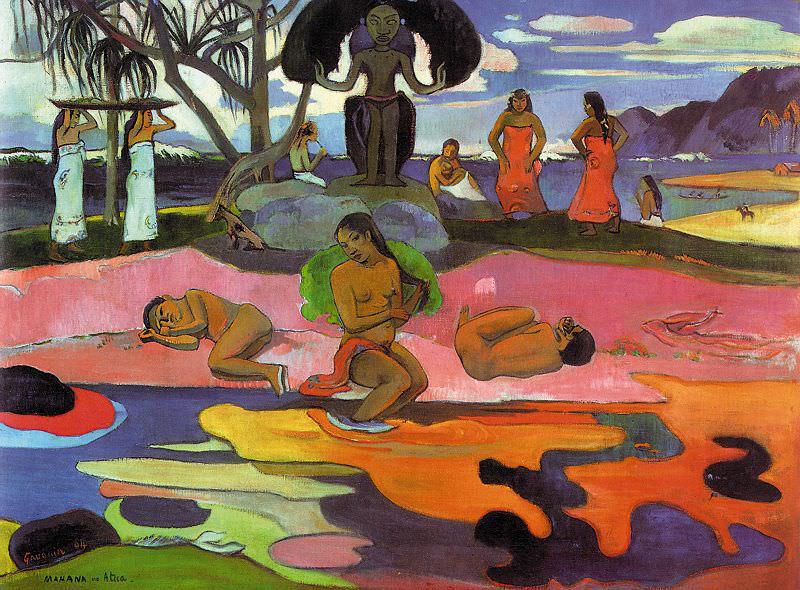gauguin12 Paul Gauguin (1848-1903)
Paul Gauguin – gauguin12
Edit attribution
Download full size: 800×590 px (0,1 Mb)
Painter: Paul Gauguin
The painting "Day of the Deity" was painted by Paul Gauguin in 1894 between the so-called "Tahitian" periods of his work. It is in the Art Institute of Chicago. This painting was part of Gauguin’s many years of research and his creative interpretation of Polynesian mythology. The main figure, called Taaroa, is the central figure of the Maori pantheon, the creator of the world, about whom the artist writes in his work Ancien Culte Mahorie.
Description of Paul Gauguin’s painting "Day of the Deity"
The painting "Day of the Deity" was painted by Paul Gauguin in 1894 between the so-called "Tahitian" periods of his work. It is in the Art Institute of Chicago.
This painting was part of Gauguin’s many years of research and his creative interpretation of Polynesian mythology. The main figure, called Taaroa, is the central figure of the Maori pantheon, the creator of the world, about whom the artist writes in his work Ancien Culte Mahorie. In honor of him the two girls on the left bring and the two girls on the right perform a ritual dance.
Here the ingenuity of the artist and his sources of inspiration are evident. The repetitive white robes of the Tahitian women, very reminiscent of Egyptian, the dancing figures, as if hanging in the air, and the deity depicted exactly corresponding to the myths that so fascinated Gauguin. The three nude figures in the foreground seem to represent creation, their languid poses (the figure on the right is even in a fetal-like pose) suggesting the overwhelming energy of the god behind them.
The curves of their figures and the headdress of the god’s feathers are reflected in the foreground. The water is filled with curious amoeba-like shapes that are perhaps rocks, or perhaps shadows that have come from some unknown place. One might assume that these are simply decorative forms designed to give the composition its own mood and rhythm. However, many art historians find here synthetic simplifications of the Brittany photographs taken in 1888 and 1889. Gauguin stylizes them to the point of almost complete abstraction.
Кому понравилось
Пожалуйста, подождите
На эту операцию может потребоваться несколько секунд.
Информация появится в новом окне,
если открытие новых окон не запрещено в настройках вашего браузера.
You need to login
Для работы с коллекциями – пожалуйста, войдите в аккаунт (open in new window).
















You cannot comment Why?
The middle ground transitions to a more grounded, earthy terrain with lush vegetation and trees. Here, two women with long dark hair carry flat baskets on their heads. A seated figure observes the scene, while a prominent dark statue, perhaps a representation of a deity or ancestral spirit, stands on a rock, its arms outstretched, framing a distant landscape. The background reveals a serene sea, rolling hills, and a bright sky with scattered clouds, creating a sense of depth and setting.
The subtexts of this painting are rich and multifaceted. Gauguin sought to capture a spiritual essence and an idealized, perhaps even primitive, existence on Tahiti, away from the perceived decadence of Western civilization. The nude figures, rendered with smooth, solid forms, evoke a sense of natural ease and connection to the environment. The vibrant, non-naturalistic colors, particularly the dominant pink, contribute to a dreamlike and spiritual atmosphere, transcending mere representation.
The presence of the idol-like statue suggests engagement with indigenous spirituality and mythology, a key element in Gauguins quest for the primitive. The contrast between the figures in repose and those in activity might allude to different states of being or aspects of the days activities. The title itself, Day of the Gods, implies a sacred or significant occasion, infusing the otherwise ordinary scene with a sense of the divine or the extraordinary. Gauguins work here is not a realistic portrayal but a subjective interpretation, aiming to evoke emotion and convey deeper symbolic meaning about nature, spirituality, and humanitys place within them.